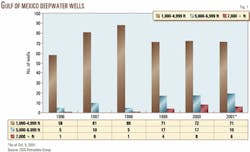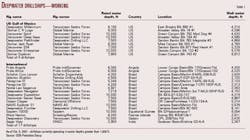Deepwater drilling activity remains steady
The number of wells drilled in the deepwater Gulf of Mexico (GOM) continues to advance steadily. In 2001, operators have drilled 96 wells through the third quarter. If the present pace continues, currently operating rigs should drill up to 120 GOM wells in greater than 1,000-ft water depth by yearend (Fig. 1).
Terry Childs, rig data manager for ODS-Petrodata Group, Houston, said out of 52 drillships and semisubmersibles in the GOM, contractors are marketing 45 of them, representing the effective supply.
Of these, 42 currently have contracts, with 8 floaters working in water depths less than 1,000 ft. The remaining 34 rigs represent 9 drillships and 25 semisubmersibles drilling GOM wells in water depths greater than 1,000 ft (Table 1 and 2).
"Activity in shallow water is lower, due to many factors including depressed natural gas prices," says Childs, but projects in the deepwater GOM normally have such a long lead time that he doesn't expect significant changes in the near term.
Click here to view Deepwater submersibles working
This table is in PDF format and will open in a new window
Childs added, "In the longer term, however, as some of these rigs get into the later years of their contracts it is difficult to know what level of rig demand will exist. As a result, we could see some idle equipment."
Ultra deepwater
Breaking down deepwater drilling activity into three subcategories provides the perspective on how operators are moving into deeper waters (Fig. 1). The last 3 years show a marked increase in deepwater wells drilled. By yearend, the industry will drill more than 25 wells during 2001, in greater than 5,000-ft water depths.
Operators drilled only two wells in 7,000 ft water depths from 1995 to 1998. Yet from 1999 to October 2001, contractors drilled 18 wells. Furthermore, over this same time period, contractors drilled 53 wells in water depths between 5,000 ft and 6,999 ft, whereas only 22 wells were drilled in this category from 1995 to the end of 1998.
Clearly the new rigs represent an important enabling technology. The industry continues to make progress, however, on the engineering and operating front, allowing operators to drill wells more quickly. One well can take more than 200 days to drill in ultra-deepwater environment.
Unocal Corp., as example, has perfected the art of drilling in deep water with a combination of dual-derrick or dual-activity drill ships, an advanced mud system, an internal benchmarking process, and a team of drillers and geoscientists who work together to understand the geology thoroughly and determine the prospect evaluation requirements.
This combined effort has allowed Unocal to drill wells such as their Dendara prospect to 24,050 ft in 38 days.
The future
The list of remaining deepwater new builds dropped from 18 to 12 during the year (Table 3). The industry took delivery of 11 rigs following construction and added 5 new rigs to be built.
Click here to view Remaining deepwater builds
This table is in PDF format and will open in a new window
Referring to the deep offshore rig fleet, Childs said, "International markets are strong right now. Unless something unpredictable happens, these markets should remain strong."
He added, "The deepwater GOM is primarily an oil province and is more insulated from gas prices than activity in shallower waters.
"By the time operators go through the planning process required for deepwater drilling prospects, it could be 2 years or more before production begins."
From this perspective, deepwater prospects are not overly affected by what are perceived to be short-term commodity price fluctuations.


